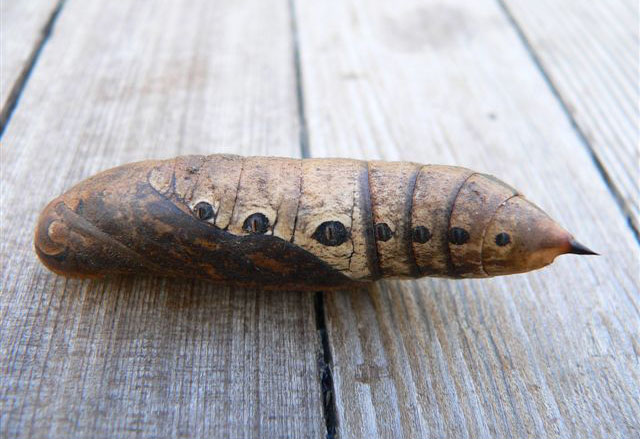
Xylophanes tersa, pupa, Shreveport, Louisiana,
March 2007, courtesy of Rosemary Seidler.
|
|
Created/dedicated as per personal communication with Rosemary Seidler, 2007; January 13, 2013; August 30, 2013 Updated as per James P. Tuttle's The Hawk Moths of North America, August 20, 2008 Updated as per personal communication with Jeff Trahan (Aellopos titan, Enyo lugubris, Manduca quinquemaculatus, Caddo Parish, October 14, 2009): January 13, 2013; April 15, 2013; June 30, 2013; August 1, 2013 |

Xylophanes tersa, pupa, Shreveport, Louisiana,
March 2007, courtesy of Rosemary Seidler.
Rosemary writes, "I found this while digging in my garden. It was an inch or two underground."
Rosemary has also sent an image confirming Hyles lineata, and she sends the following image of Agrius cingulata, both observed in Shreveport, September 24, 2003.
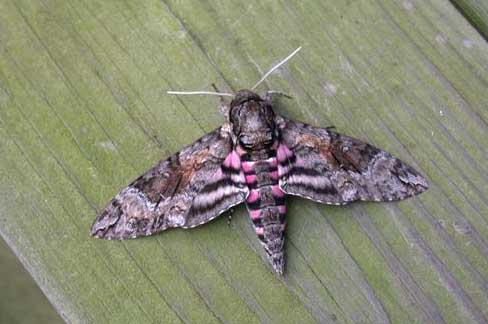
At the bottom of the page are images of Manduca quinquemaculatus, Manduca sexta and Hemaris diffinis, also sent by Rosemary Seidler. Most recently Rosemary has sent beautiful images of Amphion floridensis, available via link below the floridensis thumbnail.
Visit Caddo Parish Sphingidae larvae.
Visit Louisiana Catocala (Underwing moths).
Thirty-five Sphingidae species are listed for Louisiana on the U.S.G.S. website (now BAMONA). Not all of the species are reported or anticipated in Caddo Parish (None are reported on U.S.G.S.). It is hoped that this checklist, with the thumbnails and notes, will help you quickly identify the moths you are likely to encounter.
A "WO" after the species name indicates that I have no confirmed reports of this species in Caddo Parish, but I (William Oehlke) expect that this moth is present or might be present. A "USGS" indicates the moth is reported on the USGS website and/or in Lepidoptera of North America, #1. Distribution of Silkmoths (Saturniidae) and Hawkmoths (Sphingidae) of Eastern North America, an excellent little booklet available through Paul Opler.
Please help me develop this list with improved, documented accuracy by sending sightings (species, date, location), preferably with an electronic image, via email to Bill Oehlke.
Please also send your sightings to BAMONA, an excellent online resource.
Jeff Trahan sends the following images of Aellopos titan, Caddo Parish, October 14, 2009. This species probably occurs only as a fall stray.
Jeff continues to help with regular submissions of images and data.

Aellopos titan, Shreveport, Caddo Parish, Louisiana,
Ocotber 14, 2009, courtesy of Jeff Trahan.

Aellopos titan, Shreveport, Caddo Parish, Louisiana,
Ocotber 14, 2009, courtesy of Jeff Trahan.
Sphinginae subfamily
|
 | Agrius cingulata, WO/RS, Pink-spotted hawkmoth: Strong migrant; adults nectar from deep-throated flowers including moonflower (Calonyction aculeatum), morning glory (Convolvulus), honey suckle (Lonicera), petunia. |
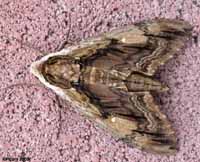 | Ceratomia amyntor WO/JT, Elm Sphinx; Four-horned Sphinx: Fw upperside: brown with dark brown and white markings including white costal area near wing base, dark streaks along veins, white spot in cell. Elm (Ulmus), birch (Betula), basswood (Tilia), cherry (Prunus). |
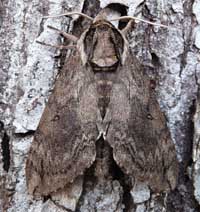 | Ceratomia catalpae WO, the Catalpa Sphinx
The upperside of the forewing is yellowish brown with no white markings, but there are indistinct black lines and dashes. The cell spot is gray with a black outline. The larvae feed in large groups and are much more
spectacular than the moths. |
 | Ceratomia hageni WO, Hagen's Sphinx; Osage Orange Sphinx: The upperside of forewing is gray with green tint and has dark indistinct wavy lines, and pale gray patches at wing tip and along costa. generally more eastern species |
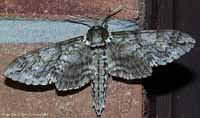 | Ceratomia undulosa WO/JT, Waved Sphinx: Fw upperside: pale brownish gray with wavy black and white lines and black-outlined white cell spot. The upperside of hindwing is gray with diffuse darker bands. |
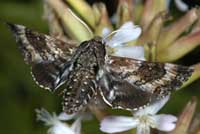 | Dolba hyloeus WO, Pawpaw Sphinx: The upperside of the forewing is dark brown with a dusting of white scales. Some moths have patches of reddish or yellowish brown on the wings. |
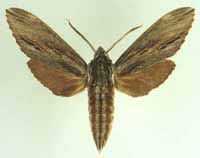 | Isoparce cupressi WO, Cypress; Baldcypress Sphinx: Isoparce cupressi, the rare Cypress Sphinx, flies in Cypress swamps in Georgia (specimen type locality), and from Maryland to Texas. It has been reported in Mexico. |
 | Manduca jasminearum WO, Ash Sphinx: The upperside of forewing is gray to grayish brown with a black line running from the middle of the costa to the middle of the outer margin; the line may be broken near the margin. There is a splash of brown around the cell spot. |
 | Manduca quinquemaculatus WO/RS/JT, Five-spotted Hawkmoth: I suspect if you grow tomatoes, you are likely to encounter Manduca quinquemaculatus. |
 | Manduca rustica WO/JT, Rustic Sphinx: Three large yellow spots on each side of abdomen. Fw upperside: yellowish brown to deep chocolate brown with dusting of white scales and zigzagged black and white lines. |
 | Manduca sexta WO/RS/JT, Carolina Sphinx: If you grow tomatoes, you have probably encountered Manduca sexta in the larval stage. Larvae get very large and can strip a tomato plant. Note checkered pattern of wing fringes. |
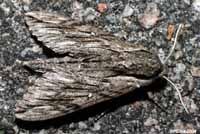 | Paratrea plebeja WO, Plebeian Sphinx: Fw upperside: gray with indistinct black and white markings. There is a series of black dashes from the base to tip, and asmall white cell spot. |
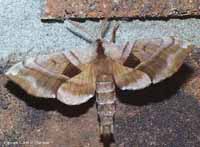 | Amorpha juglandis WO/RS/JT, Walnut Sphinx: Highly variable; sometimes wings of an individual may be all one color or may have several colors, ranging from pale to dark brown, and may have white or pink tinge. Patterns range from faint to pronounced. Female is different. |
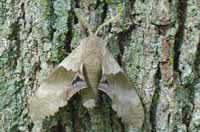 | Pachysphinx modesta WO, the Modest Sphinx or Poplar Sphinx: They are common on Prince Edward Island, and are possibility for Caddo Parish. |
 | Paonias excaecata WO/JT, the Blinded Sphinx: Dull grey-blue spot (minus dark pupil) in hindwing, this moth has a wide distribution in the eastern United States. I regularly see them on Prince Edward Island, and they are reported as far south as Florida. |
 | Paonias myops WO, Small-eyed Sphinx: Named for the small eye-spot in the hindwing, this moth has a wide distribution and is probably common in Caddo Parish. I regularly see them on Prince Edward Island, and they are reported as far south as Florida. |
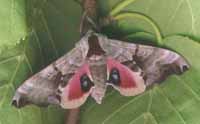 | Smerinthus jamaicensis WO, Twin-spotted Sphinx: This moth is widely distributed and fairly common. Along the East Coast, it flies from P.E.I. to Florida. |
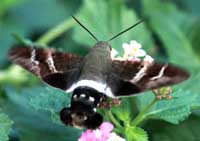 | Aellopos titan WO/JT/RS, the Titan Sphinx. possible stray; confirmed by Jeff Trahan: Body dark brown with wide white stripe across abdomen. The wings are dark brown. Hw upperside has pale patches along the costa and inner margin. |
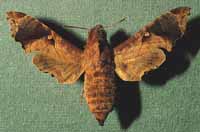
| Enyo lugubris, Mournful Sphinx, JT: Body and wings: dark brown. The forewing has large black patch covering most of outer half of wing. Pale tan cell spot (dark inner pupil), and fairly straight median line to inside of cell spot. |
 | Erinnyis obscura, Obscure Sphinx, WO: During the night adults nectar at flowers, including bouncing bet (Saponaria officinalis) and Asystasia gangetica beginning at dusk. July and August are flight times in the southern states. remote possibility |
 | Hemaris thysbe WO, the Hummingbird Clearwing: It is not difficult to see why many gardeners would mistake an Hemaris thysbe moth for a small hummingbird as it hovers, sipping nectar from flowers through a long feeding tube. |
 | Hemaris diffinis WO/RS/JT, Snowberry Clearwing; Bumblebee Moth: Adults mimic bumblebees; quite variable. Wings: basically clear, with dark brown to brownish-orange veins, bases and edges. Thorax: golden-brown to dark greenish-brown. Abdomen tends to be dark (black) with 1-2 yellow segments before tip. |
 | Eumorpha achemon WO/JT, Achemon Sphinx: Larvae get large and feed on grape vines and Virginia creeper. Note the differences between this moth and the Pandorus Sphinx. |
 | Eumorpha fasciatus WO, Banded Sphinx: Upperside: dark pinkish brown. Lighter brown band along costa, sharp pinkish white bands and streaks. Primrose-willow, Ludwigia (water primrose), other plants in evening primrose family. |
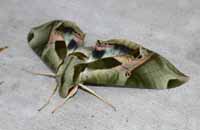 | Eumorpha pandorus WO, the Pandorus Sphinx: If you have Grape or Virginia Creeper nearby, then you probably have this species. I often get asked to identify larvae from areas not previously reported. |
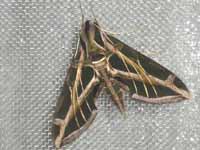 | Eumorpha vitis WO questionable, Vine Sphinx: Upperside: dark pinkish brown. Lighter brown band along costa, sharp pinkish white bands and streaks. Hindwing has pink patch on the inner margin. Note large brown parallelogram between lowest striga up to transverse lines. |
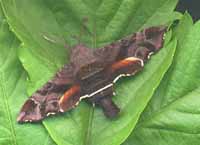 | Amphion floridensis WO/RS/JT, Nessus Sphinix: Widely distributed day-flier. If you have Virginia Creeper, you probably have the Nessus Sphinx. Two bright, distinct, narrow yellow bands are often visible on the abdomen. |
 | Darapsa choerilus WO, Azalea Sphinx: The lower wings of this hawkmoth are a solid brownish-orange, matching the body colour. You will often see this species listed as Darapsa pholus, especially in older literature. |
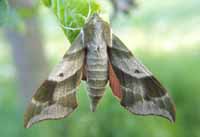 | Darapsa myron WO/JT, Virginia Creeper Sphinx; Grapevine Sphinx: If you have foodplants indicated in common names, you probably have this species nearby. Lower wings: orange. |
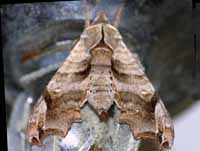 | Deidamia inscriptum WO/JT, Lettered Sphinx: Fw outer margin: deeply scalloped. The upperside is light brown with dark brown markings. There is small black and white spot near tip. Grape (Vitis), ampelopsis (Ampelopsis), and Virginia creeper (Parthenocissus) all serve as larval hosts. |
 | Hyles lineata WO/RS/JT, White-lined Sphinx: Strong migrating tendancies from much further south. There are records from New Hampshire and Maine. |
 | Proserpinus guarae WO, the Proud Sphinx: The rare and possibly endangered Proud Sphinx flies from Texas and Louisiana east to northern Florida, north to Alabama, Missouri, northern Georgia, and South Carolina. slight possibility |
 | Sphecodina abbottii WO, the Abbott's Sphinx: This moth is very much under reported across the United States. It is a rapid day flier so is probably not in too many collections. Grape is a popular larval host. |
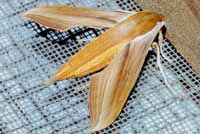 | Xylophanes tersa RS/JT, the Tersa Sphinx: This moth is very common in the south. It is a strong migrant, and sometimes establishes itself further north. |
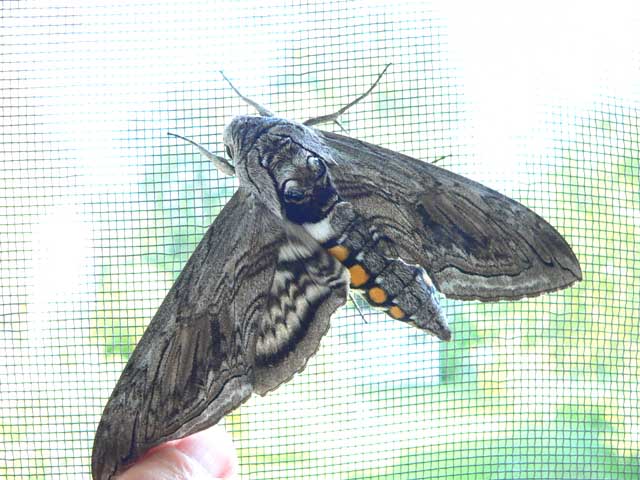
Manduca quinquemaculata, Shreveport, Louisiana, August 31, 2005,
courtesy of Rosemary Seidler.

Manduca sexta, Shreveport, Louisiana, courtesy of Rosemary Seidler.

Hemaris diffinis, Shreveport, Louisiana, courtesy of Rosemary Seidler.
Enjoy some of nature's wonderments, giant silk moth cocoons. These cocoons are for sale winter and fall. Beautiful Saturniidae moths will emerge the following spring and summer. Read Actias luna rearing article. Additional online help available.
Eggs of many North American species are offered during the spring and summer. Occasionally summer Actias luna and summer Antheraea polyphemus cocoons are available. Shipping to US destinations is done from with in the US.
Use your browser "Back" button to return to the previous page.
This page is brought to you by Bill Oehlke and the WLSS. Pages are on space rented from Bizland. If you would like to become a "Patron of the Sphingidae Site", contact Bill.
Please send sightings/images to Bill. I will do my best to respond to requests for identification help.
|

|
You can access checklists for other states, and even for other countries in the Americas (North, Central and South) via Sphingidae of the Americas.
This website has been created and is maintained by Bill Oehlke without government or institutional financial assistance. All expenses, ie., text reference support material, webspace rental from Bizland, computer repairs/replacements, backups systems, software for image adjustments (Adobe Photoshop; L-View), ftp software, anti-virus protection, scanner, etc. are my own.
I very much appreciate all the many images that have been sent to me, or of which I have been granted permission to copy and post from other websites. All images on this site remain the property of respective photographers.
If you would like to contribute to the maintenace of this website by sending a contribution to
Bill Oehlke
Box 476
155 Peardon Road
Montague, Prince Edward Island, C0A1R0
Canada
your donation would be much appreciated and would be used for
1) paying for webspace rental;
2) paying for computer maintenance and software upgrades;
3) purchases of additional text reference material (journals and books) in anticipation of expanding the site to a worldwide Sphingidae site;
4) helping to pay my daughter's tuition; with anything left over going to humanitarian aid.
If you are mailing a check from USA, please use $0.85 postage. Donations can also be made through Paypal via the button below.